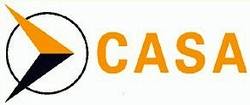AWB 27-3 Issue 1, Cessna 336/337 Flap Cable Wear
 Applicability: All Cessna 336/337 series
aircraft.
Applicability: All Cessna 336/337 series
aircraft.
Purpose: The purpose of this bulletin is to
advise operators and maintenance organisations that excessive wear
of the flap cable may exist in an area that is difficult to inspect
during the periodic check of the cable in accordance with the
maintenance manual. Excessive wear, corrosion or broken wires may
result in failure of the flap cable, which can result in asymmetric
flap deployment.
 Background: This model aircraft has suffered a number
of asymmetric flap extensions as the result of failed flap cables.
The failure of the flap cable is caused by excessive wear at the
inboard bellcrank, P/N 1462020-27. The wear location is at the
tight radius bend on the bellcrank prior to the termination point
of the cable. The cable wear is on the inside radius of the bend
and is not noticeable without removal of the cable.
Background: This model aircraft has suffered a number
of asymmetric flap extensions as the result of failed flap cables.
The failure of the flap cable is caused by excessive wear at the
inboard bellcrank, P/N 1462020-27. The wear location is at the
tight radius bend on the bellcrank prior to the termination point
of the cable. The cable wear is on the inside radius of the bend
and is not noticeable without removal of the cable.
During one incident in the USA, the pilot lost control of the
Cessna Model 336 on landing, but was able to recover control and
successfully land the aircraft without sustaining damage or
injuries. In a separate accident, again in the USA, the pilot of a
Cessna Model 337 lost control of the aircraft on landing, after
suspected asymmetric flap deployment caused by a failed flap
cable.
In addition to the above two incidents, an incident occurred in
Australia on 1 February 2003 where, on approach to land, the left
flap completely retracted. Upon investigation it was found that the
left flap operating cable P/N 1460100-7 had failed approx 1" from
the left flap inboard bellcrank P/N 1462020-27. Further
investigation revealed the right hand flap cable had broken
internal strands. These were not visible until the cable was
removed from the aircraft and carefully inspected. The cable has a
severe bend by design at the inboard bellcrank location, which
seems to exacerbate the wear and fatigue of the cable in this
location.
The Model 336/337 Maintenance Manual requires a 100 hour
inspection of the flap cable system. It is recommended that
maintenance personnel treat the left and right hand inboard
bellcranks (P/N 1462020-27) and all others in the flap system as
"critical fatigue areas". A critical fatigue area is defined by FAA
AC 43-13-1B as the working length of a cable where the cable runs
over, under, or around a pulley, sleeve, or through a fair lead; or
any section where the cable is flexed, rubbed, or worked in any
manner. It also includes cable within 1 foot of a swaged fitting.
As such, these areas require close visual inspection, which, in
this case, can only be accomplished by complete removal of the flap
cable so that hidden areas of the cable can be inspected for
excessive wear.
In addition to the requirements of the Cessna 336/337
Maintenance Manual and the requirements of FAA AC 43-13-1B,
operators maintaining the aircraft in accordance with CASA Schedule
5, must, according to Section 1 - The Airframe Part (2) (f);
"inspect the flight control system bellcranks, push pull
rods, torque tubes, cables, fairleads, turnbarrels and
pulleys".
A thorough inspection of the flap cable at the inboard bellcrank
location will require complete removal of the cable in order to
detect hidden damage.
Recommendations: Because of the criticality of
the flap cables, and the difficulty of inspecting them in situ, the
left and right flap cables should be removed and inspected for
wear, broken wires and corrosion in accordance with FAA AC
43-13-1B, chapter 7, Section 8, paragraph 7-149(d) and the
Maintenance Manual at the100 hourly or annual inspection, whichever
first.
Reporting Action: If any excessive wear, corrosion or broken wires
are detected, report it to CASA via a Major Defect Report (MDR)
form (as required by CAR 52). In the MDR form, specify the exact
location of the cable damage and include a sketch if possible
showing the location of damage in relation to pulleys, bellcranks
and other hardware. This additional information will allow CASA to
assess the fleet-wide condition of the flap cable system and
develop possible future action.
 Airbus Racer Helicopter Demonstrator First Flight Part of Clean Sky 2 Initiative
Airbus Racer Helicopter Demonstrator First Flight Part of Clean Sky 2 Initiative Diamond's Electric DA40 Finds Fans at Dübendorf
Diamond's Electric DA40 Finds Fans at Dübendorf ANN's Daily Aero-Term (04.23.24): Line Up And Wait (LUAW)
ANN's Daily Aero-Term (04.23.24): Line Up And Wait (LUAW) NTSB Final Report: Extra Flugzeugbau GMBH EA300/L
NTSB Final Report: Extra Flugzeugbau GMBH EA300/L Classic Aero-TV: 'Never Give Up' - Advice From Two of FedEx's Female Captains
Classic Aero-TV: 'Never Give Up' - Advice From Two of FedEx's Female Captains




